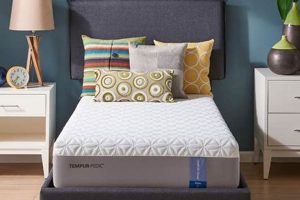The selection of a superior sleep surface significantly impacts the quality of rest obtained while in the outdoors. A well-chosen product provides insulation from the cold ground, cushions pressure points, and contributes to overall physical comfort, facilitating recuperation after strenuous activity. For example, options range from lightweight inflatable pads to thicker self-inflating mattresses, each offering distinct levels of support and portability.
Adequate sleep is crucial for physical and cognitive function during outdoor excursions. Choosing a suitable sleeping solution enhances the restorative benefits of rest, improving energy levels and concentration throughout the day. Historically, individuals relied on natural materials for ground insulation; however, modern advancements in materials science have led to the development of more effective and convenient alternatives.
This discussion will address key factors to consider when evaluating options, including material composition, insulation value (R-value), packed size, and weight. Furthermore, it will explore various types of products available, such as air mattresses, foam pads, and self-inflating models, detailing their respective advantages and disadvantages.
Tips for Selecting the Optimal Sleep Surface for Outdoor Excursions
Proper selection necessitates consideration of several crucial factors to ensure adequate comfort and support. Evaluating the following will significantly improve the outdoor sleep experience.
Tip 1: Prioritize Insulation (R-Value): Assess the R-value, which measures resistance to heat flow. Higher R-values are essential for cold-weather camping to prevent heat loss to the ground. Consider at least an R-value of 4.0 for temperatures near freezing.
Tip 2: Evaluate Packed Size and Weight: Optimize for portability. Backpackers should seek lightweight and compact options that minimize pack volume. Consider inflatable models designed for minimal packed size.
Tip 3: Assess Support and Comfort: Determine the level of firmness and support required. Individuals with back pain may benefit from thicker or more structured models. Consider closed-cell foam pads for firm support or air mattresses for adjustable comfort.
Tip 4: Examine Durability and Material: Opt for durable, puncture-resistant materials, especially when camping on rough terrain. Look for models constructed from heavy-duty nylon or polyester with reinforced seams.
Tip 5: Consider Inflation Method: Evaluate the convenience of the inflation method. Self-inflating models offer ease of use, while air mattresses require a pump (manual or electric). Ensure compatibility with available power sources or carry a manual pump as backup.
Tip 6: Review User Feedback: Examine user reviews and ratings to gauge the reliability and performance of specific models. Pay attention to comments regarding durability, comfort, and ease of use in various conditions.
Tip 7: Determine the Type : Consider the type based on camping style, for example, Air Mattress is suitable for car camping, while Foam Pads are best for backpacking.
Careful consideration of these factors will result in a choice that contributes to a more restful and enjoyable outdoor experience. Investing in a quality option is an investment in overall well-being during camping trips.
The subsequent sections will delve into specific product recommendations and further refine the selection process, offering insights into achieving optimal comfort and performance.
1. Comfort
The subjective sensation of comfort is paramount when evaluating sleep surfaces for outdoor use. A product’s ability to provide adequate support, cushioning, and pressure relief directly impacts sleep quality and overall user satisfaction. Therefore, comfort constitutes a critical determinant in the selection of the optimal outdoor sleeping solution.
- Surface Material and Texture
The material in direct contact with the sleeper’s body significantly influences comfort. Smooth, breathable fabrics minimize friction and promote airflow, reducing the likelihood of overheating or skin irritation. In contrast, rough or non-breathable materials can lead to discomfort and disrupted sleep. For example, brushed polyester or microfiber surfaces are often preferred for their soft feel and moisture-wicking properties.
- Support and Firmness
The level of support provided by the sleeping surface dictates spinal alignment and pressure distribution. An excessively soft surface may lead to spinal misalignment and exacerbate back pain, while an overly firm surface may create pressure points and discomfort. The ideal firmness level varies depending on individual preferences and sleeping position. Options such as adjustable air mattresses allow for customized support levels to accommodate diverse needs.
- Thickness and Cushioning
The thickness of the mattress directly affects its cushioning ability and insulation value. Thicker mattresses generally offer greater cushioning and better insulation from the cold ground. However, increased thickness also contributes to greater weight and packed size, which may be a limiting factor for backpacking. The optimal thickness represents a compromise between comfort and portability, depending on the specific application.
- Conformity and Pressure Relief
The ability of the sleep surface to conform to the sleeper’s body contours is crucial for minimizing pressure points. Materials like memory foam excel at conforming to the body, distributing weight evenly and reducing pressure on sensitive areas such as hips and shoulders. Products that lack sufficient conformity may result in localized pressure points and discomfort, particularly for side sleepers.
Ultimately, the perception of comfort is highly individual and influenced by factors such as sleeping style, body weight, and personal preferences. Evaluating these elements in conjunction with the specific requirements of the camping environment is essential for identifying a solution that maximizes sleep quality and promotes restorative rest during outdoor pursuits.
2. Insulation
Insulation is a critical determinant of the suitability of any sleep surface for camping, especially in environments with low ambient temperatures. The primary function of insulation is to impede heat transfer between a warm body and a cold surface. Without sufficient insulation from the ground, heat is rapidly conducted away from the body, potentially leading to discomfort, hypothermia, and compromised sleep quality. The correlation between ground temperature and insulation performance is direct: as ground temperature decreases, the required insulation value increases to maintain thermal equilibrium. For example, a sleeping surface with an R-value of 2.0 may
be adequate for mild summer nights, but insufficient for temperatures approaching freezing.
The effectiveness of insulation in a camping sleep surface is quantified by its R-value, a measure of thermal resistance. Higher R-values indicate greater insulating capability. Materials like closed-cell foam and synthetic fills trap air within their structure, creating a barrier to heat flow. Air mattresses, while often comfortable, provide minimal insulation unless specifically designed with internal baffles and insulating materials. Real-world consequences of inadequate insulation include restless sleep, shivering, and reduced energy levels the following day, diminishing the overall camping experience and potentially jeopardizing safety. Selecting a sleep surface with an appropriate R-value for anticipated conditions is therefore an essential aspect of trip planning.
Ultimately, understanding the role of insulation in sleep surface performance allows for informed decision-making. Challenges arise in balancing insulation with other factors such as weight and pack size, particularly for backpacking. However, prioritizing insulation, especially in colder environments, enhances comfort, safety, and overall effectiveness. The investment in a sleep surface with sufficient insulation is a direct investment in physical well-being and the ability to fully participate in outdoor activities. The “best mattress for camping,” therefore, inherently integrates effective insulation properties as a core functional component.
3. Portability
Portability is a fundamental characteristic dictating the practicality of a sleep surface in diverse camping scenarios. The correlation between portability and suitability for camping stems from the inherent need to transport equipment, often over considerable distances and challenging terrain. The inverse relationship between size/weight and ease of transport necessitates a compromise; larger, more comfortable options may prove impractical for backpacking, while ultra-lightweight alternatives might sacrifice comfort and insulation.
The impact of portability is particularly evident in backpacking and backcountry camping. In these contexts, every ounce and cubic inch of pack volume directly affects mobility and endurance. A heavy, bulky sleep surface can significantly increase the physical strain, leading to fatigue and reduced enjoyment of the outdoor experience. Conversely, a compact, lightweight option allows for efficient packing and improved maneuverability on trails. Examples include inflatable sleeping pads that compress to the size of a water bottle and weigh less than a pound, enabling multi-day expeditions without excessive burden. The trade-off between comfort and portability should be carefully evaluated based on the intended use and individual physical capabilities. Overlooking this aspect can lead to discomfort, decreased mobility, and potentially unsafe situations.
The practical significance of understanding the role of portability is clear: it allows for optimized gear selection tailored to specific camping requirements. Choosing a sleep surface that balances comfort with transportability ensures both adequate rest and the ability to navigate the wilderness effectively. Prioritizing portability translates directly to a more enjoyable and sustainable outdoor experience, minimizing physical strain and maximizing freedom of movement. Therefore, portability constitutes a crucial aspect when evaluating alternatives.
4. Durability
The service life and resistance to damage exhibited by a sleep surface are critical factors influencing its suitability for camping. The capacity to withstand the rigors of outdoor use directly impacts the long-term value and reliability of the product.
- Material Composition and Tear Resistance
The inherent strength of the materials used in construction dictates resistance to punctures, tears, and abrasion. Heavy-duty nylon or polyester fabrics, often reinforced with ripstop weaving techniques, enhance resistance to damage from rocks, branches, and rough ground surfaces. Lower-quality materials are more susceptible to tearing, leading to air leaks or loss of structural integrity.
- Seam Construction and Reinforcement
Seams represent vulnerable points in the structure of any inflatable sleep surface. High-quality construction techniques, such as welded or reinforced seams, minimize the risk of separation or air leakage under pressure. Weak or poorly constructed seams are prone to failure, rendering the product unusable.
- Valve Integrity and Reliability
The inflation valve is a critical component responsible for maintaining air pressure within the mattress. Durable valves, constructed from robust materials and designed for secure sealing, prevent air leaks and ensure reliable inflation and deflation. Fragile or poorly designed valves are prone to damage, compromising the functionality of the product.
- Resistance to Environmental Degradation
Exposure to sunlight, moisture, and temperature fluctuations can degrade materials over time, reducing their strength and flexibility. UV-resistant coatings and waterproof treatments enhance the product’s ability to withstand environmental factors, extending its lifespan and maintaining its performance in diverse conditions.
Considering these aspects collectively facilitates the selection of a product designed to endure the demands of outdoor environments. A higher initial investment in a robust and durable sleep surface often translates to long-term cost savings and improved reliability, making it a relevant factor in evaluating the optimal equipment.
5. Packed Size
Packed size is a critical consideration in determining the suitability of a sleep surface for camping. The correlation between packed size and overall camping experience arises from constraints imposed by transportation and storage. A smaller packed size facilitates easier integration into backpacks or vehicle cargo spaces, maximizing available room for other essential gear. A large packed size, conversely, can limit the quantity and type of equipment that can be carried, directly impacting the comfort and safety of the trip. For example, a full-sized air mattress, while comfortable, often possesses a prohibitive packed size for backpacking, rendering it unsuitable for wilderness excursions. Therefore, packed size operates as a practical constraint, influencing the feasibility of different sleep surface options in specific camping contexts. The selection of a “best mattress for camping” necessitates the prioritization of compact dimensions alongside other factors such as comfort and insulation.
The practical application of understanding packed size is evident in scenarios such as multi-day hiking trips. Where weight and space are at a premium, a self-inflating pad or foam pad that can be rolled tightly becomes essential. These options exemplify efficient designs, maximizing comfort and insulation while minimizing the space occupied within a pack. In contrast, situations such as car camping afford greater latitude, enabling the selection of larger, more luxurious mattresses without compromising portability. Evaluating the available space and tr
ansport capacity is paramount. Overlooking the packed size factor can result in an inability to carry necessary equipment, leading to discomfort, inconvenience, or, in extreme cases, compromising safety.
In summary, the packed size characteristic directly influences the practicality and suitability of a camping sleep surface. A compact packed size improves efficiency in transportation and storage, maximizing available space for other vital gear. While comfort and insulation remain important, ignoring the dimensions can severely limit the possibilities of a camping excursion. Achieving the “best mattress for camping” necessitates a balanced approach, weighing comfort and insulation against considerations related to packed size, ensuring that the selected surface is compatible with the constraints of the camping environment and methods of transport used. The challenge involves finding an optimal compromise between the desire for comfort and the practical requirements of limited space, thereby facilitating an improved outdoor experience.
Frequently Asked Questions About Camping Sleep Surfaces
This section addresses common inquiries concerning the selection and use of sleep surfaces designed for outdoor environments.
Question 1: What is the most crucial factor to consider when selecting a sleep surface for cold-weather camping?
The insulation value, or R-value, is paramount. A higher R-value indicates greater resistance to heat loss, preventing conduction of body heat to the cold ground. A minimum R-value of 4.0 is recommended for temperatures near freezing.
Question 2: How does the packed size of a sleep surface affect its suitability for backpacking?
Packed size directly influences the amount of available space in a backpack. A smaller packed size allows for more efficient use of space and reduces overall weight, improving mobility and reducing strain during long hikes.
Question 3: What are the advantages of a self-inflating mattress compared to an air mattress?
Self-inflating mattresses typically offer a better balance of comfort, insulation, and ease of use. They automatically inflate to a certain degree and often have an insulating foam core. Air mattresses, while potentially more comfortable, require a pump and often provide less insulation.
Question 4: What materials are most resistant to punctures and tears in outdoor environments?
Heavy-duty nylon or polyester fabrics with reinforced ripstop weaving offer superior resistance to punctures and tears. These materials are less likely to be damaged by rocks, branches, and other abrasive surfaces.
Question 5: How can one prolong the lifespan of a camping sleep surface?
Proper storage, cleaning, and maintenance can extend the lifespan of a sleep surface. This includes storing it in a dry place, protecting it from direct sunlight, and repairing any punctures or tears promptly.
Question 6: Is there a correlation between the cost of a sleep surface and its overall quality?
While price is not always indicative of quality, higher-priced models often incorporate more durable materials, advanced construction techniques, and innovative features, which can translate to improved performance and longevity.
In summary, the selection of a sleep surface involves careful consideration of insulation, packed size, material durability, and overall comfort. Balancing these factors ensures an improved outdoor sleeping experience.
The subsequent section will explore specific product recommendations and comparisons, further refining the decision-making process.
Concluding Remarks on Selecting the Optimal Sleep Surface for Camping
The foregoing analysis has explored the multifaceted considerations inherent in choosing the most appropriate sleep surface. The assessment of insulation value, packed size, durability, and, of course, comfort, remains paramount in the decision-making process. The relative importance of each attribute necessarily depends on the specific camping context, whether involving lightweight backpacking, extended wilderness expeditions, or car camping scenarios.
Achieving a superior outdoor rest experience demands a balanced assessment of multiple factors. The selection of the “best mattress for camping” constitutes a significant investment in physical well-being and performance during outdoor activities. Therefore, careful deliberation and informed decision-making are essential for ensuring the selection of a product optimized to specific needs and environmental conditions. Neglecting this diligence may compromise sleep quality and detract from the overall enjoyment of outdoor pursuits.


![Top Best Mattress Black Friday Deals of [Year] for Sleep! Organic & Natural Mattress Buyer’s Guide: Non-Toxic Sleep Solutions Top Best Mattress Black Friday Deals of [Year] for Sleep! | Organic & Natural Mattress Buyer’s Guide: Non-Toxic Sleep Solutions](https://mattressworldpa.com/wp-content/uploads/2025/07/th-7679-300x200.jpg)


![Top Rated: Best Infant Mattress [Guide & Reviews] Organic & Natural Mattress Buyer’s Guide: Non-Toxic Sleep Solutions Top Rated: Best Infant Mattress [Guide & Reviews] | Organic & Natural Mattress Buyer’s Guide: Non-Toxic Sleep Solutions](https://mattressworldpa.com/wp-content/uploads/2025/07/th-7676-300x200.jpg)

